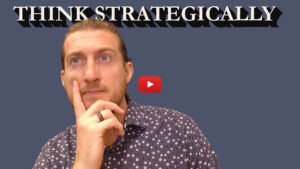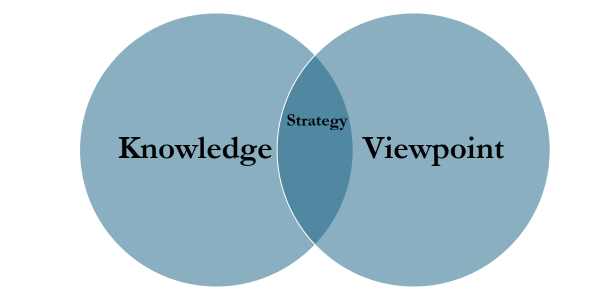Let’s spend some time together working on Strategic Thinking for business growth.
When working ON the business, we can
- Do tangible things – working on skills, developing systems,
- Or we can do more thought-based, higher-level work.

When thinking ON the business, strategy is one of those key areas to think about.
In this post,
- We will define strategy.
- I’ll give some examples to make sure it’s clear what we’re talking about when we’re talking about strategy.
- Finally, we’ll do a step-by-step approach of how you can start thinking about strategy for the very first time in your business.
What Is Business Strategy?
Strategy is your approach to business.
It can be thought of as where your knowledge and your viewpoint meet.
That intersection is strategy.

If you have different viewpoints, your strategy will be very different from someone else with a variety of other viewpoints.
If you have different knowledge and core skills, the available viewpoints are also different. I know that sounds kind of confusing, as I even say it out loud.
Examples Of Strategic Approaches
Breaking it down more with specific examples, if you look at chess players,
- There are some people who play chess in a very aggressive style. They love the chaos, throwing pieces everywhere, making crazy trades, very bold, exciting movements. Those are very aggressive players.
- There are also chess players who like to play a very slow, methodical style. They set up their pieces so they have a turtle wall of defense up. It’s hard to break through. It seems like no move against them is a good move. They like to have a lot of control over things.
Now, it’s not like the chess player just sat down and thought, I want to play aggressively.
Their approach came out of their personality, their natural tendencies of what they feel comfortable with and their viewpoint.

In The Art of Learning, Josh Waitzkin, the author, talks about being a young chess prodigy and going to tournaments. He would play against people he had never met before, and he’d like to sit out in the Hawaiian weather, and he would watch for the rain to come.
He could tell, based on how people reacted to the rain, if they’re going to be an aggressive player or a controlling player.
The aggressive players would just let the rain fall right on their heads; they embraced the chaos. They didn’t care to get wet. They would just stroll on to their destination.
The control-focused, positional players would get their umbrellas up, shuffle out of the rain as quickly as possible to avoid that happening. So you can see how viewpoint and personality actually affect strategy in a very big way.

Strategy can be thought of as the art form, the viewpoint, the way that you approach a specific task.
How To Apply Strategic Concepts In Your Business
Let’s look at step-by-step how to actually do strategy work in your business. It’s actually easier than you might think.
- Acknowledge your strategy.
- Notice inconsistencies.
- Find opportunities to double down.
- Use your Strategy as your North Star.
Acknowledge
Number one is acknowledging your Strategy’s existence.
This may sound like a big homework project.
“I have to sit down and think and imagine a Strategy.”
When in reality, 99% of business owners I talk to, already have a strategy they’re living out. They just haven’t taken the time to notice what that is.
Some common ways that this shows up include
- Some owners feel that “if I do a good job with customers and build trust, I’ll have ongoing repeat and referral business. That’s the core of what I do.”
- Or “if I do ongoing follow-up, treat them like a family member, I’ll have ongoing follow-on business.”
- Or “if I never over-recommend services, I’ll have very happy customers.”
- Or “if I’m only ever helping out people to the best of my ability, they’ll always appreciate that.”
Those are all variations on the idea of focusing on value and doing a really, really good job.
Now what’s interesting is when you try to acknowledge your own Strategy is it’s so self-evident to you, it seems like there’s no alternative.
Everyone must surely be doing that. But in reality, that’s not the case.
There are other people in your marketplace, your competitors, possibly, who may focus more on their own personal Strategy of building wealth as important to them, and the cost of doing so is irrelevant.
So if they’re over-recommending work or not treating clients well, knowing they can churn and get another one, that’s part of their Strategy that gets them what they want based on their personality.
Acknowledging your own Strategy is the first step.

Notice Inconsistencies
The second step is noticing inconsistencies.
If you know, for example, your Strategy is focused on value and clear communication, and if you notice that you also feel like you should be the lowest-priced person in the marketplace, then you’ll recognize there’s an inconsistency there.
It’s hard to be focused on the best value, doing the best job with the best trust, and ALSO being the lowest price, because it’s hard to stay in business and justify focusing on that time and energy.
So what’s probably happening is you’re living out one real Strategy, and then another one is “I’m supposed to be doing X or Y or Z,” or “I have fear that if I were to charge what I’m worth, people wouldn’t use me.” And that causes your Strategy to go off in two opposite directions that can’t really coexist.
Focusing on quality while also focusing on being the cheapest in a marketplace is almost impossible.
(If you have to choose, I say focus on quality every time. That’s a sustainable way to build strong relationships going forward for repeat and referral business. That’s going to be the best path forward, typically.)

Once you’ve really had a good idea of what your actual Strategy is,
- what you value
- what’s important
- what’s your viewpoint
- what your approach is
you can notice “What are the ways that I’m living out that don’t actually match that Strategy?”
If you truly believe that doing an amazing job will lead to all the repeat and referral business that you ever could want, then why are you so worried about having a low price? Isn’t the purpose of doing that quality work to get that additional work, not the price?
If you like price as your key strategy, great, stick with that.
But it’s important to notice that sometimes, if we have Strategies in different directions, we can actually get in our own way.
Once you have identified your Strategy, notice inconsistencies and cut those out so you can stay focused on what the actual important Strategy is.
Find Opportunities To Double Down On Your Strategy
Where are your chances to double down on this strategy?
For instance, maybe you value communication with customers incredibly highly.
If that is your Strategy, you’re going to make sure whenever a customer buys something from you, it’s never in “gobbledygook”, they always know exactly what it is they’re getting, why it went wrong, and what they can do to stop it from happening in the future.
If that is your number one thing, how can you double down on that?
Can you provide that information in writing?
In a video?
Is there a different way you can take it one level higher?
That usually helps you live out your Strategy even more fully, and oftentimes, there are very small micro solutions that don’t actually involve much additional work to get there.

Use Your Strategy As Your North Star
Now that you have your Strategy, you’ve noticed any types of inconsistencies, you’ve doubled down on what’s working, and that becomes your North Star.
Wherever you’re headed, you recognize
- What you value most based on your viewpoint?
- What’s important to you?
- How do you want to express yourself?
This is when business becomes almost an art form.
A painter paints a painting in a certain way based on how they’re feeling, how they’d like to express themselves.
Business is the same way.
When you get into the Strategy side of things, this is when business becomes more and more fun and more and more about self-expression.

Prioritize Strategic Thinking In Your Business
We’ve talked about what strategy is.
We’ve talked about some examples of strategy and the four key steps in actually working through strategy in your business.
A reasonable expectation is probably within an hour or two of thinking, and some focused time with a paper in front of you, you probably can map most of this out!
Don’t worry about having 100% clarity, but just spending a little bit of time to reflect on this can really make sure you’re pointed in the right direction and making choices in line with your Strategy and aligned with your personal beliefs.

The Power Of Groups
I would challenge you, if you are having some struggles with this, to reach out to other business owners in your area and discuss with them what their approach to business is, what they value the most, what their viewpoint is, and see how you differ.
You can see a lot of really good businesses have slightly differing opinions on how to run a business, what strategy might look like, and some may be drastically different. And that can help guide you and shape you and see what makes yours different and how you can double down on it.
If you have any questions, let me know.
This might be a post to send to somebody else you know who’s a business owner, so you can have that strategy discussion with them from a similar point of context.
Let’s spend a couple of hours mapping that out.
That’ll help lead to tactics thinking later, and the day-to-day operations thinking after that!
Best of luck to you. Have a good one.




You must be logged in to post a comment.